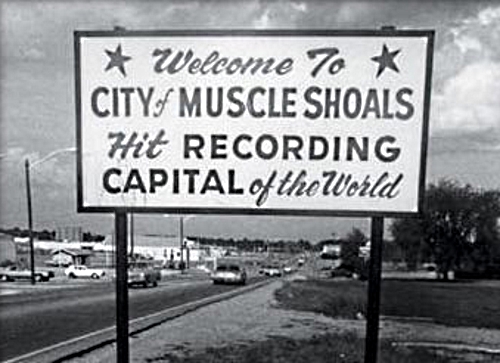
MSRS: The Next Generation
Their departure opened the way for a second generation of pickers to coalesce around Hall’s studio. This new blood, which eventually included the core quartet of the Muscle Shoals Rhythm Section, became the propelling force behind a succession of hits by Wilson Pickett (“Land of 1000 Dances” and “Mustang Sally”), Arthur Conley (“Sweet Soul Music”) and Percy Sledge (“When a Man Loves a Woman”). But it was the Aretha Franklin sessions that finally brought fame to Muscle Shoals’and got the rhythm section out of town.
Although Aretha’s only trip to Alabama produced two of her most memorable recordings (“I Never Loved a Man” and “Do Right Woman”), some frictions involving members of her entourage made the experience upsetting. Wexler, not wanting to break up the winning combination, decided to bring the rhythm section to New York.
“I was really kind of scared by the whole trip,” says Roger Hawkins. “I was just a kid at the time, from the rural South, and here I was going to play in a studio on Broadway with Aretha Franklin. I was barely twenty at the time, and I had butterflies in my stomach.”
Jimmy Johnson found the experience both rewarding and intimidating. “Every time we went up to New York, I thought it would be the last time. But we were crossing our fingers, eyes, legs and toes hoping it wouldn’t be.”
It was a challenge for Alabama players. Accustomed to spontaneous “head arrangements”, they suddenly had to contend with a sophisticated, uptown approach.
“Arif Mardin was working with Jerry and [engineer] Tom Dowd on most of those session,” recalls Johnson. “He was so much more aware in musical terms. It also got complicated because he had just come from Turkey and didn’t speak very good English, while we, being Southern, were trying to figure things out by reading his lips.”
Somehow, the messages got through. For the next two years, the Muscle Shoals musicians were traveling regularly to New York and later Miami for sessions with King Curtis and Solomon Burke as well as Aretha. It was the close ties to Atlantic that gave them the courage to make a bold move in 1968: they bought their own studio.
Project Studio Soul: The Casket Factory
Fred Bevis, who had converted an old casket factory at 3614 Jackson Highway into a four-track studio, was ready to sell. The four musicians pooled their assets and bought it. With a promise or steady work from Wexler, they immediately upgraded to eight track.
Their first project for Atlantic was Cher, and although that project was reasonably successful, it was the next visitor who would firmly establish the studio’s FM album rock credentials.
At the time, only bassist David Hood had even heard of the Steve Miller Band, and he had not looked closely enough at the album jackets to remember the face of Boz Scaggs. He eased into town, introducing himself (backed by co-producer/publisher Jann Wenner) as a reporter for the Rolling Stone.
He hung out for two or three days, left, and came back several weeks later to cut a milestone record-an underground classic that marked the only collaboration between Scaggs and the studio’s lead guitarist at the time, Duane Allman.
“We had fun playing on that one,” recalls Beckett. “We enjoyed it because we could loosen up and play what we wanted to play. We were dying to shake off the tight discipline of some of the New York sessions.”
It wouldn’t be long before the Muscle Shoals musicians had a chance to loosen up even more. In the next installment to appear next week, we’ll look back at sessions with Paul Simon, Traffic, Jimmy Cliff and Bob Seger.
After signing Cliff to Island Records in 1971, label owner and producer Chris Blackwell was determined to introduce Cliff to wider audiences both in America and Europe. Deciding it might help to cut some songs with more of an R&B flavor, Blackwell brought gun to Muscle Shoals where, according to Hawkins, “we cut six, eight, maybe even ten songs.”
Several cuts, including “Sitting in Limbo,” ended up on the soundtrack of the cult reggae film, “The Harder They Come.”
Says David Hood: “Jimmy brought a bunch of Jamaican records with him-old ska singles, by the Upsetters and groups like that. We were amazed by that sound, and it showed us a few things, like the ways to turn the beat around. It planted a seed with us.”
That seed came to fruition quickly with the Staple Singers hit, “Respect Yourself,” a lively blend of American R&B and classic reggae rhythm.
Cliff’s hits were sleepers, but Blackwell soon came back for another round. He had the English supergroup Traffic under his wing, a brilliant but unstable aggregation that seemed to be falling apart from the outset.
By that time, drummer Jim Capaldi had decided to move from behind the drums to front man, and the group had never really filled the bass player slot. Blackwell recruited the reluctant duo of Hood and Hawkins, booking the studio solid for the duration of the 1972 summer tour to ensure their cooperation. Jimmy Johnson came along to mix FOH, while Barry Beckett took an excursion to L.A.
After U.S. and European tour legs, they all returned to Muscle Shoals to record “Shootout at the Fantasy Factory”– a quickie that the Alabama contingent found unsatisfying.
“We had never seen anything like them,” says Hood. “Chris Wood was freaking out in one direction, Reebop was freaking out in another, Winwood was becoming a recluse and Capaldi was determined to play the rock star role.
“Roger and I struggled to keep things together. We tried to build a solid foundation that they could go crazy over.”
